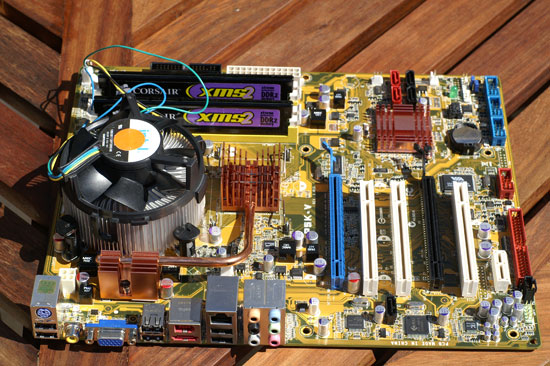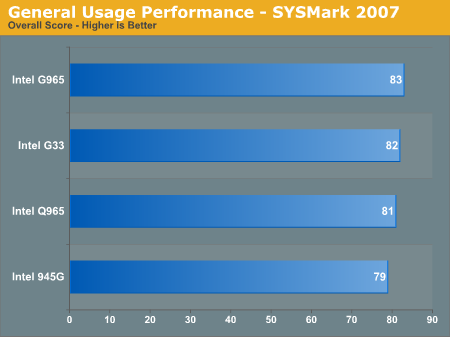Midrange CPU Roundup: It's Time to Buy
by Anand Lal Shimpi on September 28, 2007 2:00 AM EST- Posted in
- CPUs
Motherboards - Affordable and Integrated
The desktop chipset market has evolved over the past few years; it used to be that the bulk of mainstream chipsets were supplied by vendors like SiS and VIA, but now with mature chipsets from AMD and NVIDIA the landscape has changed considerably.
Motherboards with integrated graphics previously were often poor performers, plagued by terrible graphics drivers, but with AMD and NVIDIA running the game now things are different. The integrated graphics drivers are now based off of the same drivers that discrete GPUs use, so overall performance, compatibility and stability are much improved.
How Cheap Can You Go? Intel Chipset Comparison
One thing many users don't realize is that chipsets as much as two generations old can still be made to work with modern day processors. Manufacturers like MSI still offer 945G based motherboards but with Core 2 Duo support, the benefit being a much cheaper motherboard at the slight sacrifice of performance.

ASUS' P5K-V uses Intel's new G33 chipset
You can get an Intel G33 based motherboard for around $90 - $110, a G965 will cost you around $70 - $100, but you can find a 945G for somewhere around $60 - $70. At the time of publishing, Newegg even had an open box buy for $40.

MSI is still shipping 945G based motherboards with Conroe support
The question is, how much performance do you give up by going with an older chipset? The focus of today's article is mostly CPU performance but let's look at a few general purpose benchmarks. The Intel chipset results are extremely self explanatory:

There are minor performance differences between the chipsets, mostly because memory and chipset technology hasn't changed dramatically over the past two generations. There have been significant improvements in Intel's integrated graphics, but if you're building a headless machine or something where you don't need a minimum level of 3D graphics performance then any of these Intel chipsets will work just fine. The 945G falls behind the most because the fastest memory we can use in it is DDR2-667, whereas all of the other chipsets officially support DDR2-800. If you're building a cheap second system or a fileserver though, the performance difference honestly doesn't matter.
The desktop chipset market has evolved over the past few years; it used to be that the bulk of mainstream chipsets were supplied by vendors like SiS and VIA, but now with mature chipsets from AMD and NVIDIA the landscape has changed considerably.
Motherboards with integrated graphics previously were often poor performers, plagued by terrible graphics drivers, but with AMD and NVIDIA running the game now things are different. The integrated graphics drivers are now based off of the same drivers that discrete GPUs use, so overall performance, compatibility and stability are much improved.
How Cheap Can You Go? Intel Chipset Comparison
One thing many users don't realize is that chipsets as much as two generations old can still be made to work with modern day processors. Manufacturers like MSI still offer 945G based motherboards but with Core 2 Duo support, the benefit being a much cheaper motherboard at the slight sacrifice of performance.

ASUS' P5K-V uses Intel's new G33 chipset
You can get an Intel G33 based motherboard for around $90 - $110, a G965 will cost you around $70 - $100, but you can find a 945G for somewhere around $60 - $70. At the time of publishing, Newegg even had an open box buy for $40.

MSI is still shipping 945G based motherboards with Conroe support
The question is, how much performance do you give up by going with an older chipset? The focus of today's article is mostly CPU performance but let's look at a few general purpose benchmarks. The Intel chipset results are extremely self explanatory:

There are minor performance differences between the chipsets, mostly because memory and chipset technology hasn't changed dramatically over the past two generations. There have been significant improvements in Intel's integrated graphics, but if you're building a headless machine or something where you don't need a minimum level of 3D graphics performance then any of these Intel chipsets will work just fine. The 945G falls behind the most because the fastest memory we can use in it is DDR2-667, whereas all of the other chipsets officially support DDR2-800. If you're building a cheap second system or a fileserver though, the performance difference honestly doesn't matter.










44 Comments
View All Comments
jonp - Sunday, September 30, 2007 - link
I too wonder about the Netburst admonition. There are probably millions of Netburst CPUs out there that are happily computing away with no thought of Anandtech at all; doing their thing; producing great results for their owners. The biggest concern I have seen is thermal and that, only in relation to overclocking. Assuming there are more than a few users that don't need to or want to overclock; then there are some great bargins in used Netburst Processors and accompanying motherboards.It doesn't appear to me that "...if you know what's best for you." is either technical, professional or helpful. Maybe it was meant as a joke...sorry it's not that funny.
HotdogIT - Friday, September 28, 2007 - link
Yes, you did. Given the combination of power usage savings, pure performance benefits, and overclocking ability (since you mentioned 3.6ghz on the Pentium D, I assume we can go with at least 2.4 out of an e2140, for comparisons sake), the C2D/Pentium E line is much better.
The problem with a lot of the "lol Pentium D overclocking" articles is they fail to overclock what they're comparing against. You take a Pentium D 805 and OC it to 4ghz, sure, the performance delta over an e2140 will be big. But apply the same cooling and thought into OCing the e2140, and that delta will swing the other way.
ThatLukeGuy - Saturday, September 29, 2007 - link
So what would make the most sense to change out the Pentium D805 to that would keep me at (or better yet raise the bar of) the performance I'm getting now? An OC'd e2140 or something higher up the ladder? I'm matching this to a 2gigs ram, an nice MSI SLI plat mobo, and an 8800gts320mb. I'd want something that wouldn't bottleneck the system which is what the P.D805 did when it was stock.
HotdogIT - Sunday, September 30, 2007 - link
It's going to depend on a lot of factors. If you're gaming, a change in the CPU may very well do very little in changing any performance; especially at a higher resolution, the CPU may make NO difference.
I'd look into the e2140/e2160/e4X00 line, if you wanted to stay lower cost. At the VERY least, you'll get a boost in energy efficency: The Pentium Ds were and are power hogs, especially compared to the newer line.
What performance did you see increase when you overclocked the Pentium D? Did gaming increase? If so, then a C2D based system would be much better, regardless of an overclock; Netburst just don't handle the games as well.
If, somehow, you're running something that is AMAZINGLY well tuned for Netburst, you may see less of an increase. But these applications are rare these days, so I doubt you'd see that in most cases.
Parhelion69 - Friday, September 28, 2007 - link
Anand did you do the power consumption tests on the overclocked cpus? I think it's important to know, if you haven't, can't you at least give us a rought estimation? It'd be greatly appreciated. Thanks.dm0r - Friday, September 28, 2007 - link
Thats a great article Anand, I missed this kind of roundup.Enjoyed a lot and the only thing is missing is the performance per watt, but anyway very good article.Thanks for sharing!eetnoyer - Friday, September 28, 2007 - link
Why not throw in the 4200+? I know it's 90nm, but I just got one for $74, and (for me)it looks like the sweet spot of price/performance for AMD. And, given how well tuned their 90nm process is at EOL, I wouldn't be surprised to see power consumption close to that of the 65nm chips. If you want, you could use the 65W version (it's only a buck more).Uter - Friday, September 28, 2007 - link
Anand, is the BE-2400 still coming out? Or, when you say that there are two Athlon X2 BE Processors, the BE-2350 and BE-2300, is that a subtle hint that we shouldn't expect to see it? I just want to make sure I pick one of these up while there are still available...bogda - Friday, September 28, 2007 - link
Oveclocking results are not fair. You chose horrible motherboards for AMD overclocking.For example, Biostar AMD motherboards cost 50-60 euros. They are much better overclockers than MSI or ASUS you chose. My Athlon BE-2300 easily overclocks from default 1,9GHz to over 2,8GHz with stock HSF.
wdb1966 - Sunday, September 30, 2007 - link
I completely agree, the boards chosen for the AMD chips are horrible.Gigabyte's MA69GM-S2H and Abit's NF-M2 nView would have been far superior choices in every way...poor motherboard choices, very poor.